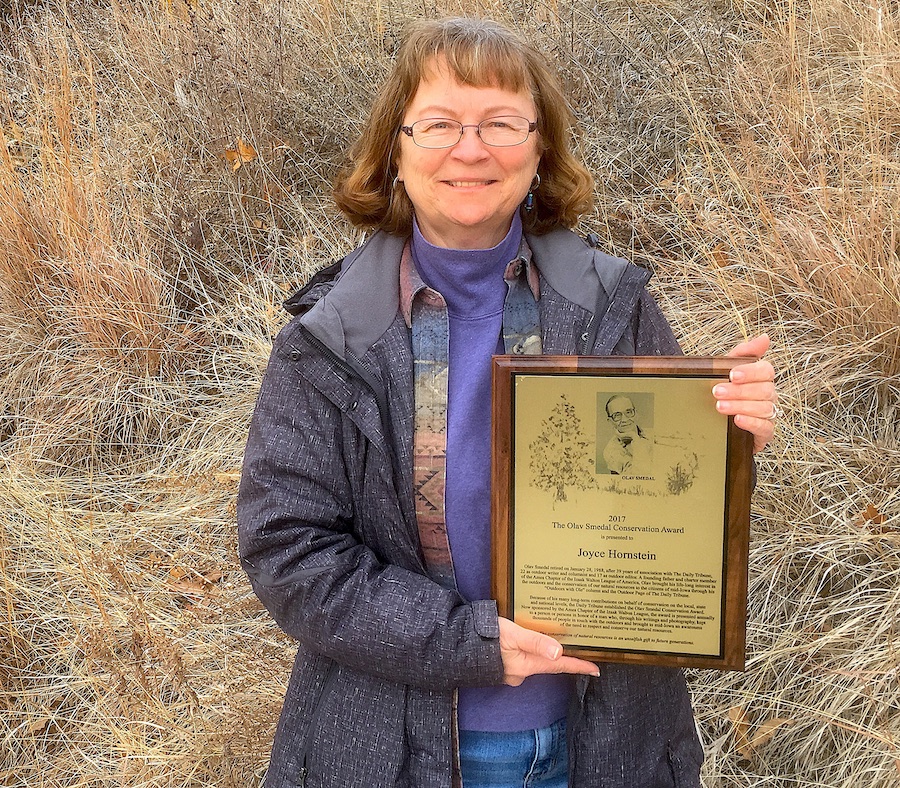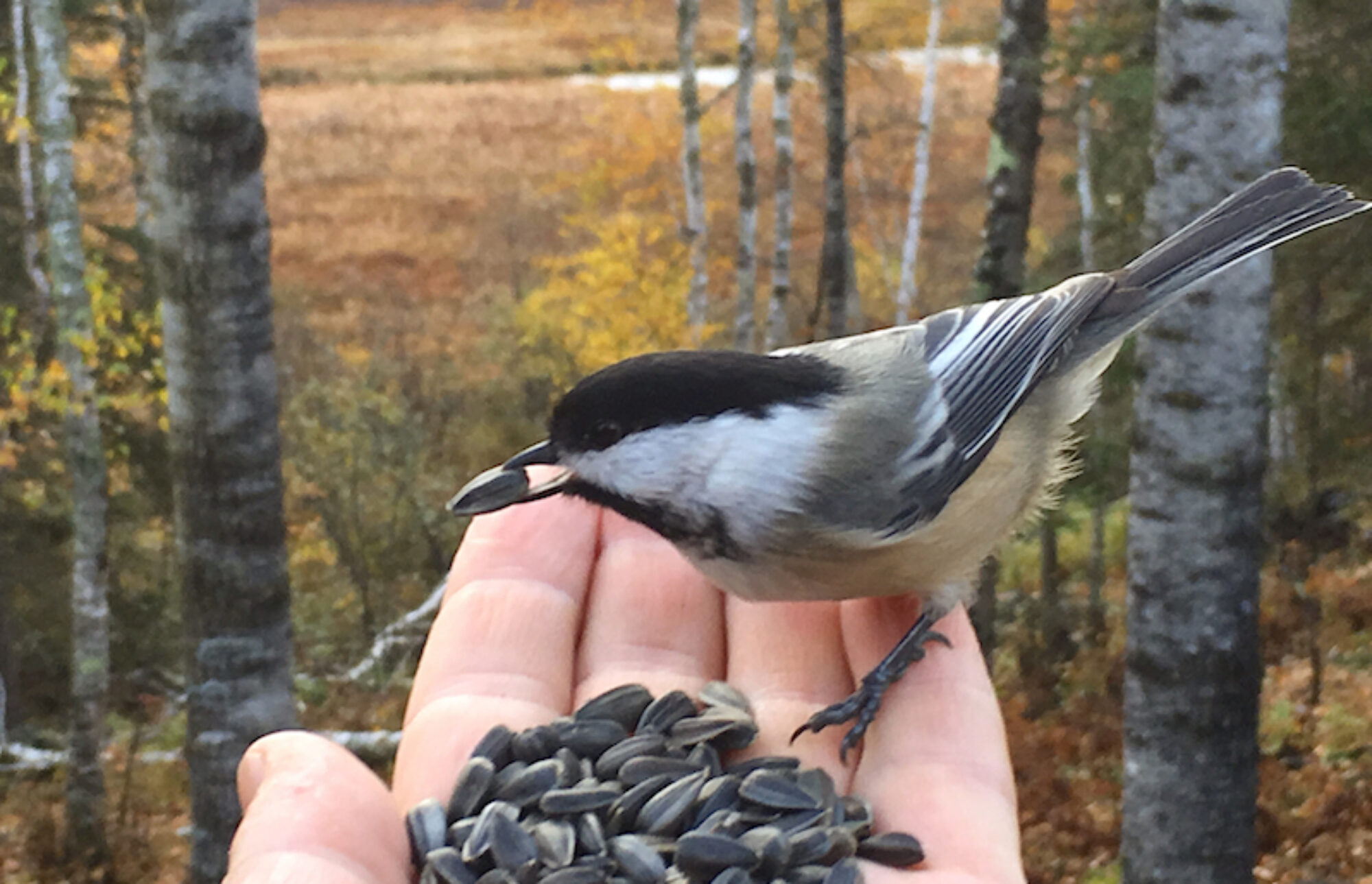
Joyce Hornstein stands in front of a prairie planting near her home in Huxley. Hornstein is the 2017 recipient of the Olav Smedal Conservation Award. Photo by Todd Burras
By Todd Burras
My path with Joyce Hornstein first crossed on a sunny spring day some 15 years ago at Richard W. Pohl Memorial Preserve, or more commonly known as Ames High Prairie. A few years earlier I had rebooted the weekly outdoors page for the Tribune, continuing a tradition that had been established and sustained for nearly four decades by Olav Smedal, and there on a verdant plant-covered slope I stood hoping to learn a few things about prairies and, more specifically, prairie plants.
A few years earlier, I had rebooted the weekly out- doors page for the Tribune, continuing a tradition that had been established and sustained for nearly four decades by Olav Smedal, and there on a verdant plant-covered slope I stood hoping to learn a few things about prairies and, more specifically, prairie plants.
I had recently completed a master conservationist class with Story County Conservation where one evening we’d spent an hour or so with Tom Rosburg, a Drake University professor or ecology and botany, who had class participants down on all fours counting the number of different plant species we could identify based solely on the visual differences of the plants we could see.
It was one of those notable moments in my informal education in science that blew my mind. I had absolutely no idea what prairie was or how diverse, complex and important it was in recounting the history of a state in which I had lived my entire life.
It was ironic, if not a bit sobering, that I had grown upon a farm in a state that once was almost entirely Tall Grass Prairie yet I knew nothing about prairies and virtually nothing about any of the state’s other natural resources. State history wasn’t a focus of my formal or informal educational upbringing. Iowa, I grew up believing, was home to soybeans and corn. And, at that time, a few cattle and hogs. Prairies were something only a few young girls read about in Laura Ingalls Wilder novels.
It turns out Joyce Hornstein didn’t read “Little House on the Prairie” novels as a youngster. Rather, she lived a modern-day version of the story. While we both grew up on farms in rural Iowa, our upbringings, in many ways, couldn’t have been much different.
Growing up on a crop and livestock farm along the wooded North Fork of the Maquoketa River in Dubuque County, Joyce and her sisters heard lots of stories from their parents and grandparents about the Dust Bowl and the Great Depression.
This was a generation after the arrival in the state of the Civilian Conservation Corps and the integration of various conservation practices that included building contours on hilly ground, such as the land her parents and while taking botany and land management classes that Joyce’s “mind was opened to prairie before trees.”
A deeper connection and devotion to prairies began to take root and blossom during Joyce’s career at ISU that included working in agronomy and entomology — 19 years of which were for the Extension Service.
During that time, she took a master conservationist class in Polk County and was a founding member of the Iowa Prairie Network. Eventually, she served on the Story County Conservation Board from 2005 through 2014, including chair in both 2008 and 2014, and has volunteered countless hours for both Polk and Story counties, mainly with seed harvest and trail work.
“I just love prairies,” she says. “I’ve always loved plants, and with plants the animals come with it. What could be better?”
Thinking back to that first encounter with Joyce at Pohl Preserve and sub- sequent meetings in the weeks and months that followed, it would be hard to argue with her assertion.
After all, it was with Joyce’s patience and guidance that I was first introduced to plants with imaginative names like blue wild indigo, hoary puccoon, pale spiked lobella, Virginia spiderwort, daisy fleebane, butterfly milkweed and porcupine needle grass, a sample barb of which is still pressed in a field guide I carried during those outings and as sharp as the day it was picked.
In a bit of irony or serendipity, the home Joyce and her husband, Scott, live in outside of Huxley is situated on an oak and hickory savannah, similar to the land she grew up on in northeastern Iowa where she learned the ethics about life and conservation that she lives and imparts to others.
“I think what’s important is we really have to be stewards of the land, air, water and one another,” she says. “I wish more people understood that.”
Todd Burras can be reached at ou****************@gm***.com.
Name: Joyce Hornstein
Lives: lived in and near Huxley since 1977
Grew up: along the North Fork of the Maquoketa River in Dubuque County.
Education: Iowa State University Bachelor of Science degree in botany; ISU Master of Science degree in agronomy
Family: husband, Scott, and two cats
Worked: retired from ISU; worked in agronomy and entomology, including 19 years for ISU Extension
Volunteers: various conservation groups including Story and Polk County Conservation and the Iowa Prairie Network; Ballard Community Performing Arts Association Board
Hobbies: hiking, bird watching, playing in local community band, reading
Favorite native plant species: wow, there are so many — prairie clovers, blue flag iris, cardinal flower, oak trees
Favorite public green spaces in Iowa: Hayden Prairie State Preserve, Effigy Mounds National Monument, White Pine Hollow Wildlife Management Area in Dubuque County, Rochester Cemetery in Cedar County
Olav Smedal Conservation Award
The Olav Smedal Conservation Award is given annually in honor of the late Tribune outdoors editor by the Ames Chapter of the Izaak Walton League of America and Story County Conservation. The award goes to an individual or individuals who, by their actions or communications, has or have done the most to accurately present to the public of central Iowa excellence in the conservation of natural resources and outdoor pursuits while representing the highest standards of ethics and sportsmanship.
To nominate someone for the award, contact Mike Meetz at mc******@gm***.com.
Olav Smedal Award Recipients
1988 – Dale Brentnall
1989 – Bill Horine
1990 – Steve Lekwa
1991 – Nancy Kurrle
1992 – Cele Burnett
1993 – David Van Waus
1994 – Robert Pinneke
1995 – Jim Pease
1996 – George Patrick
1997 – Ed Powell
1998 – Mike Meetz
1999 – Linda & Hank Zaletel
2000 – Ervin Klaas
2001 – Cindy Hildebrand
2002 – Jim Dinsmore
2003 – Todd Burras
2004 – Jim Colbert
2005 – John Pohlman
2006 – Rick Dietz
2007 – Jimmie Thompson
2008 – Linda & Carl Kurtz
2009 – Gaylan & Lloyd Crim
2010 – Deb Lewis
2011 – Tom Rosburg
2012 – Marlene & Bruce Ehresman
2013 – Kerry “Pat” Schlarbaum
2014 – Mike Todd
2015 – Wolf Oesterreich
2016 – Hank Kohler
